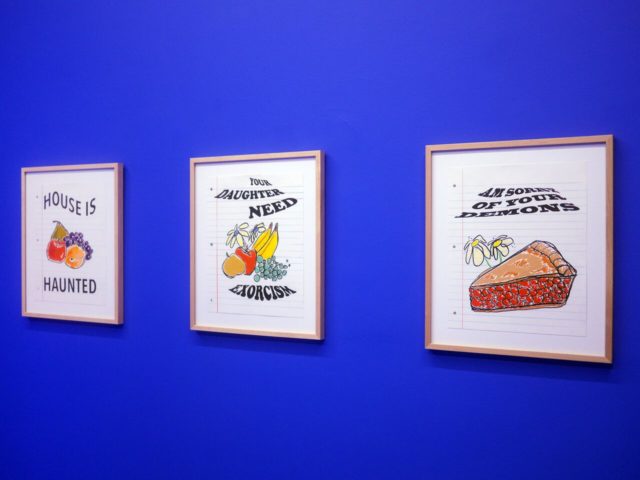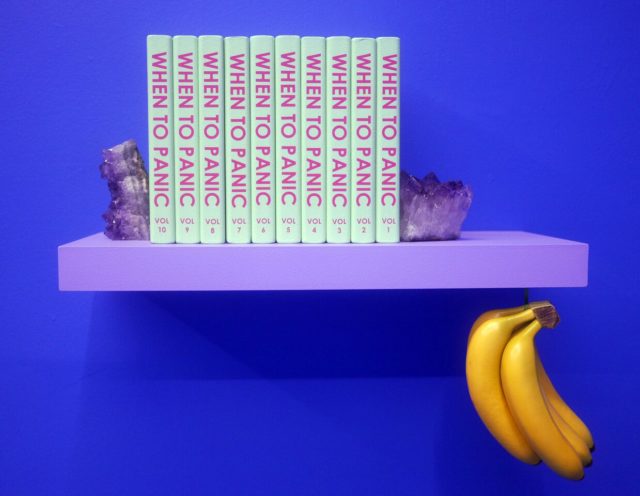
Eric Mistretta, installation view at Anna Kustera
Visiting Eric Mistretta’s current show, “Bad Doctor,” at Anna Kustera (on through October 2nd), feels a lot like walking into the mind of a mad pop culture meta-physician. He’s turned the gallery into a glowing ultramarine chamber complete with glowing violet crystals and a pentagram painted on the floor. At first glance, the show looks like it’s a celebration of New Age beliefs and all the accouterments that go along with the lifestyle.
A longer look at some of those accouterments creates a more macabre interpretation . “Healing” crystal book ends flank volumes of “When to Panic,” self help books. Seemingly pleasant, yet ominous paintings, give one the sense that all this magic isn’t intended to save the viewer from more malevolent forces at play.
I sat down with Mistretta to discuss superstition, human foibles, the saving graces of humor. We even looked at the importance of belief and the way we construct meaning in everyday life.
Irena Jurek: Where did the idea for your show, “Bad Doctor” come from?
Eric Mistretta: For the show, I envisioned a weird doctor’s waiting room. The space is small so I knew I wanted to make a room. It’s an opportunity to incorporate paintings and sculpture and have them act as parts of a whole. When you think of a doctor you think of someone who will be helpful. You need to believe that’s true. So the term bad doctor seems particularly ominous to me, because there is a lot at stake and you are handing over the reins to someone else. I like that notion of something that’s meant to be beneficial, but could potentially go very wrong. That’s the sentiment that I want to manifest in the work as well.
More generally, though, I’ve been thinking about fruit, animals, science, and flowers. There’s an indisputable beauty found in nature that is kind of unfuckwithable. These are the eternal source materials and what people have been painting forever.
IJ: People invest a lot of trust into doctors.
EM: Exactly. I’m interested in that vulnerability. You trust someone with something, but what if the information that they give you is faulty?
IJ: That could extend to a variety of different situations; it could be a metaphor for things going wrong in general.
EM: Yes that sort of high wire idea is appealing to me, teetering on the brink of badness!
IJ: You also have these clichéd images hanging in the doctor’s office installation, so you have this contrast between the pretty, generic imagery and the more grim aspects of your idea.
EM: Definitely. That sentiment finds its way into the work as well, especially with the fruit. I’m attracted to this corny looking, childishly rendered fruit. I’ve been thinking of the fruit as an offering or a consolation of some sort.

Eric Mistretta at Anna Kustera
IJ: Well it’s also so funny. In one of the fruit paintings you’ve used the text, “Your Daughter Need Exorcism.”
EM: I came up with this narrative of a shaman or witch doctor that is trying to console the parents of a girl who is possessed by some kind of evil spirit. The parents receive this horrible news, but a fruit basket as well.
IJ: You’re creating this comically surreal environment. It’s especially interesting since you don’t strike me as being superstitious in the least.
EM: I wouldn’t say I’m superstitious, but I like other people who are superstitious, you know?
IJ: It’s fascinating,
EM: I’m interested in that thought process. I even find myself occasionally wanting to be superstitious, because I think it’s probably easier.
IJ: It seems more comforting than acknowledging the void of nothingness.
EM: Right! You want to believe that if I put my shoes in this exact spot at the top of the stairs when I come home, that tomorrow I will start the day with some sense of control, because I know exactly where my shoes are.
IJ: Or that 13 matters as a number!
EM: Yeah, I mean it’s weird that there isn’t a thirteenth floor listed in buildings, and that that idea has worked its way into elevators.
IJ: It’s strange because when we think of superstition, we often think of it existing in the past rather than the present, although superstition has never really left us. Even when you think of something like science, much of the information we accept as factual is provisional and subject to change.
EM: Yes and that idea can be applied to the general psychology of people and the ways in which people use these beliefs and rituals to help them relax. It’s whatever you have to do in order to deal with what’s confronting you at the moment. I know that in times of duress I have done some pretty weird shit to calm down.
IJ: Well, we all believe in crazy things that aren’t realistic to some degree. It’s just that some people are just more obvious about it.
EM: Right! It can also be alarming when someone points out a craziness we weren’t aware of having.
IJ: Well, it’s our blind spot.
EM: But it can be enlightening, too. It’s like a jarring glimpse at the way your own brain works.
IJ: You also seem to relish in imperfections and mistakes, which is apparent in your use of text and signage.
EM: Yes, I love when you see signs that are trying to be serious and earnest, but whoever made the sign basically failed since there are spelling or grammar mistakes, or the layout is weird and fucked up. Someone put effort into trying to make this thing look genuine or appealing, and you only notice that it’s wrong. Essentially the sign becomes about itself, because the whole thing is a mistake. I enjoy manufacturing that error in some of my work.
IJ: That all goes back to your fascination with the idea of failure.
EM: Right, I think that failure or even the pathetic has a dynamic quality in an artwork. It winds up being kind of compelling. Like you are rooting for the thing to get its shit together and succeed.

Erik Mistretta at Anna Kustera
IJ: Your show covers the subject of lying, too. You have this doctor who is posing as someone who is helpful, and you have the office that seems welcoming on the surface when in fact it’s actually hostile.
EM: I was thinking about a sort of mischievousness lurking beneath the surface, as well as the idea of “shitty help” or “shitty advice.”
IJ: Thinking about that idea of “shitty advice,” another possibility occurred to me, that maybe the doctor wasn’t necessarily bad; there just wasn’t anything that the doctor could do for the patient.
EM: Futility is another idea that I’m attracted to. Trying your best in the face of imminent disaster.
IJ: Well, we can all take care of our health, which is important, but there’s a certain point where we’re all going to die no matter what. And that’s not going to be pleasant.
EM: There’s the dread in knowing that we will die one day, but there is also a strange comfort. It’s the comfort of a deadline. Ha! You have an allotted amount of time to get things done.
IJ: Exactly! If we knew we would never die we would experience a different sort of dread. Would you say that your work is autobiographical?
EM: I didn’t used to think so, but the more I think about it, I more that I think it is. I suppose that in a way the patient is me. All these pseudo therapeutic paintings that I’ve made or what I like to think of as “shitty therapy.” The paintings are an effort to calm me down, but I never believe them, and that’s why they have that undertone of sarcasm.
IJ: What you’re saying reminds me of that famous Duchamp quote, “There is no solution, because there is no problem.” in that you seem to be saying the opposite. “The problem exists, because there is no solution.”
EM: I think the solution can wind up being dependent on how deeply someone is willing to believe in it. And that’s related to a sentiment I try to instill in the work. I want the work to transmit a kind of hopefulness in the face of great adversity. It’s the classic relationship between tragedy and comedy. They depend on each other, and there is a magic place when they are in perfect balance. That’s the place to go after.


Comments on this entry are closed.